About the Organ
and the Chapel
Born in 1750 and raised in Bordeaux, France, Stephen Girard came to the United States in 1776. From construction, shipping and banking, Girard eventually became the country’s wealthiest citizen. He is perhaps best known for an $8 million loan to the United States treasury that enabled the nation to continue fighting the War of 1812.
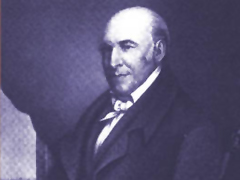
Stephen Girard
Upon his death in 1831, Girard left an estate worth $7 million, $5 million of which went to founding Girard College, a private, tuition-free school for fatherless boys, as Girard himself had been. While a religious man, Girard expressly decreed that nowhere on campus should be found any representation of sectarianism. To this day, no ordained clergy are permitted on the grounds.
When the College opened in 1843, the Chapel was located within Founders Hall, a splendid Greek Temple. A later, Victorian Gothic chapel was erected, and fitted with a Jardine organ built in 1878. An Austin organ replaced the Jardine in 1924, but the building was removed to make way for a new structure completed in 1933. The architects, Thomas, Martin & Kirkpatrick of Philadelphia, interpreted Girard’s views in the brief to:
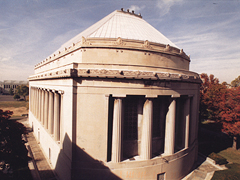
Girard College Chapel
erect a Chapel which should conform in style with the other buildings on the Campus, which are chiefly of the Greek Revival, and yet be in no sense reminiscent of an architectural style associated with any existing faith — a Chapel nonsectarian throughout, welcoming all creeds and giving offense to none, a Chapel that without benefit of reredos, baldachin, altar, pulpit or other outstanding expression of any sect should devise its own dramatic climax [Walter Thomas and Sydney Martin, Architectural Record, June 1933]
The Skinner Organ Company of Boston was contracted in late 1930 for a comprehensive four-manual instrument. Space for the organ was gradually worked out with the architects, who initially proposed matching side chambers near the front. These would not accommodate the contracted organ, however, and a ceiling location was ultimately chosen.
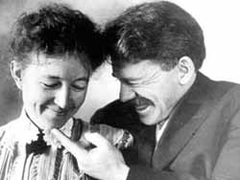
Ernest and Mabel Skinner
When the Girard contract was signed, artistic direction at the Skinner Organ Company was in an uneasy state of transition. Ernest Skinner, the author of the high orchestral organ in America, was beginning to be overshadowed by G. Donald Harrison, the English-born and -trained builder who had joined Skinner in 1927. Younger organists were moving away from orchestral effects and towards earlier organ music; some were beginning to request Harrison’s supervision in writing. With each such contract, Skinner grew more irate.
At Girard, however, Skinner was on safe ground, thanks to two loyal supporters: Skinner’s Philadelphia salesman Cliff White and Girard’s organist Harry Banks. Although initial engineering consultations were with G. Donald Harrison, control of the job landed squarely with Skinner, who supervised construction details and tonal design. It seemed to have everything: a magisterial Great, from 32’ Violone through two mixtures and four chorus reeds; a luxurious Swell, again with four chorus reeds; a Choir abounding in coloristic effects; a Solo in which the usual orchestral colors were paired to a choir of Tubas, large mixture and heraldic Tuba Mirabilis; and a Pedal with four 32-foot registers. Skinner was not deaf to the reforms Harrison advocated, but he set about creating a new, more brilliant organ in his own way, from the 18-rank Great chorus to a more melodic approach to treble finishing.
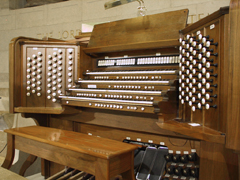
Austin Console - 1985
Although the instrument was not completed until May 1933, construction began in 1931. This chronology may explain such older features as hand-engraved stopknob lettering, which was phased out once Skinner had merged with the organ department of the Aeolian Company in January 1932 to become Aeolian-Skinner. The long gestation allowed for other refinements, such as with the Tuba Mirabilis, originally to be enclosed. On October 22, 1931 Skinner wrote to Banks asking that it be placed outside the box, where it could be especially commanding. “If you will agree to this,” wrote Skinner, “I will promise you a Tuba without equal in Philadelphia.”
Glorious acoustics and a lavishly complete specification marked this instrument as a triumph for Skinner. Only a few months after its completion, however, Skinner was stripped of his power at Aeolian-Skinner. Although he went on to build a few more “authentic” Skinners at a new firm with his son, history has made of Girard the last authoritative Skinner statement. Although the organ has undergone some changes (one Great mixture replaced, Solo Tuba choir and Pedal Bombarde revoiced), it remains a defining instrument of the late romantic style, in an acoustical and architectural environment of commanding grandeur.
|
Organ Specification
| Specifications in PDF Format |
 |
Printable Stoplist |
| GREAT (unenclosed) |
SWELL |
| 32 |
Violone |
16 |
Bourdon |
| 16 |
Diapason |
8 |
Diapason |
| 8 |
First Diapason |
8 |
Geigen |
| 8 |
Second Diapason |
8 |
Salicional |
| 8 |
Principal Flute |
8 |
Voix Celeste |
| 5-1/3 |
Quint |
8 |
Viol d’Orchestre |
| 4 |
Octave |
8 |
Viol Celeste |
| 4 |
Principal |
8 |
Gedeckt |
| 2-2/3 |
Twelfth |
8 |
Flauto Dolce |
| 2 |
Fifteenth |
8 |
Flute Celeste (t.c) |
| IV |
Chorus Mixture |
4 |
Octave |
| IV |
Harmonics |
4 |
Flute Triangulaire |
| 16 |
Trumpet |
2-2/3 |
Nazard |
| 8 |
Tromba |
2 |
Flautino |
| 4 |
Clarion |
IV |
Cornet |
|
Harp |
V |
Chorus Mixture |
| Celesta |
16 |
Posaune |
| Chimes |
8 |
Cornopean |
| |
8 |
French Trumpet |
| GREAT (enclosed with Choir) |
8 |
Oboe d’Amore |
| 8 |
Third Diapason |
8 |
Vox Humana |
| 8 |
’Cello |
4 |
Clarion |
| 8 |
Stopped Diapason |
|
Tremolo |
| 8 |
Erzähler |
Harp |
| 8 |
Erzähler Celeste (CC) |
Celesta |
| 8 |
Trumpet |
Chimes |
| |
| ECHO |
SOLO |
| 8 |
Diapason |
8 |
Gamba |
| 8 |
Wald Flute |
8 |
Gamba Celeste |
| 8 |
Echo Gamba |
8 |
Flauto Mirabilis |
| 8 |
Dulcet |
4 |
Flute |
| 4 |
Flute Triangulaire |
VII |
Grand Fourniture |
| 8 |
Vox Humana |
16 |
Corno di Bassetto (ext.) |
|
Tremolo |
8 |
Corno di Bassetto |
| Echo on Choir |
8 |
English Horn |
| Echo on Solo |
|
Tremolo |
|
8 |
French Horn |
| PEDAL |
16 |
Contra Tuba |
| 32 |
Resulant |
8 |
Harmonic Tuba |
| 32 |
Open Diapason (ext.) |
4 |
Clarion |
| 32 |
Violone (Great) |
|
Chimes |
| 16 |
Diapason |
8 |
Tuba Mirabilis (unenc.) |
| 16 |
Metal Diapason (Great) |
|
| 16 |
Contra Bass (Great) |
CHOIR |
| 16 |
Bourdon |
16 |
Dulciana |
| 16 |
Echo Lieblich (Swell) |
8 |
Geigen Diapason |
| 16 |
Dulciana (Choir) |
8 |
Viol d’Orchestre |
| 8 |
Octave (ext.) |
8 |
Viol Celeste |
| 8 |
Principal (Great Violone) |
8 |
Concert Flute |
| 8 |
Gedeckt (ext.) |
8 |
Dulciana |
| 8 |
Still Gedeckt (Swell) |
8 |
Unda Maris (t.c) |
| 4 |
Flute (ext.) |
8 |
Spitz Flute |
| V |
Mixture |
4 |
Octave Dulciana |
| 32 |
Bombarde (ext.) |
4 |
Flute d’Amore |
| 32 |
Fagotto (ext.) |
2-2/3 |
Dulciana Twelfth (ext. 4) |
| 16 |
Trombone |
2 |
Dulciana Fifteenth (ext. 4) |
| 16 |
Fagotto |
2 |
Piccolo |
| 16 |
Bassoon (Choir) |
III |
Carillon |
| 8 |
Tromba (ext.) |
16 |
Bassoon |
|
8 |
Clarinet |
| 8 |
Orchestral Oboe |
| CD Materials in PDF Format |
|
Tremolo |
 |
CD Booklet |
Harp |
 |
Tray Card |
Celesta |
 |
CD Disc Label |
Chimes |
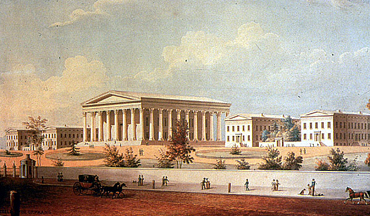
Thomas U. Walter: "Girard College, Philadelphia" 1833-48
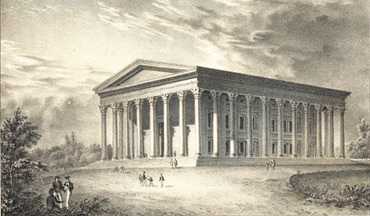
Thomas U. Walter: "Girard College, Main Building" 1833-48
|